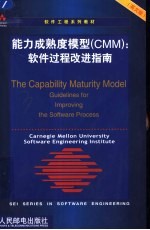

能力成熟度模型 CMM:软件过程改进指南 英文版PDF电子书下载
- 电子书积分:14 积分如何计算积分?
- 作 者:(美)Carnegie Mellon University Software Engineering Institute著
- 出 版 社:北京:人民邮电出版社
- 出版年份:2002
- ISBN:711510672X
- 页数:441 页
PART ONE THE CAPABILITY MATURITY MODEL FOR SOFTWARE:BACKGROUND,CONCEPTS,STRUCTURE,AND USAGE 1
1 INTRODUCING SOFTWARE PROCESS MATURITY 3
1.1 The Evolution of the CMM 5
1.2 Immature Versus Mature Software Organizations 7
1.3 Fundamental Concepts Underlying Process Maturity 8
Figure 1.1 Process:holding the pieces together 9
1.4 Total Quality Management and the CMM 10
Figure 1.2 Applying TQM to software 11
1.5 Customer Satisfaction 12
1.6 Benefits and Risks of Model-Based Improvement 12
2 THE SOFTWARE PROCESS MATURlTY FRAMEWORK 15
Figure 2.1 The five levels of software process maturity 16
2.1 Behavioral Characterization of the Matrity Levels 17
2.2 Skipping Maturity Levels 20
2.3 Visibility into the Software Process 22
Figure 2.2 Visibility into the software process at each maturity level 23
2.4 Prediction of Performance 24
Figure 2.3 Improving control,predictability,and effectiveness 26
Figure 2.4 Process capability as indicated by maturity level 28
3 THE STRUCTURE OF THE CAPABILITY MATURITY MODEL 29
3.1 Internal Structure of the Maturity Levels 30
3.2 Maturity Levels 30
Figure 3.1 The CMM structure 31
3.3 Key Process Areas 32
Figure 3.2 The key process areas by maturity level 33
3.4 Key Practices 39
3.5 Common Features 40
4 INTERPRETING THE CMM 41
4.1 Interpreting the Key Practices 41
4.2 The Key Process Area Template 42
4.3 Interpreting the Common Features 46
4.4 Organizational Structure and Roles 59
4.5 Understanding Software Process Definition 65
Figure 4.1 Conceptual software process framework used in the CMM 66
4.6 The Evolution of Processes 74
Figure 4.2 The key process areas assigned to process categories 75
Figure 4.3 The evolution of software project management 76
4.7 Applying Professional Judgment 77
5 USING THE CMM 81
Figure 5.1 The IDEAL approch to software process improvement 82
5.1 A CMM-Based Appraisal Method 83
Figure 5.2 A software process apprasial method based on the CMM 84
5.2 Process Assessments and Capability Evaluation 85
5.3 Software Process Improvement 86
5.4 Using the CMM in Context 89
Figure 5.3 "M"is for model 90
6.1 Introduction 93
6 A HIGH-MATURITY EXAMPLE:SPACE SHUTTLE ONBOARD SOFTWARE 93
Figure 6.1 Failure history for delivered operational increments of Onboard Shuttle software since 1988 94
6.2 Background 95
Figure 6.2 Functional structure of Onboard Shuttle Flight Software 96
Figure 6.3 Allocation of Onboard Shuttle staff by function 98
6.3 Approaches to Process Improvement 98
Figure 6.4 Chronology of process improvements implemented by the Onboard Shuttle project 99
Figure 6.5 Control board structure for managing the Onboard Shuttle project 100
Figure 6.6 The requirements management process for the Onboard Shuttle project 105
Figure 6.7 Percentage of total injected faults detected prior to verification testing 106
Figure 6.8 Faults detected per thousand lines of code during the verification testing of Onboard Shuttle software 109
Figure 6.9 The Onboard Shuttle software defect prevention process 110
Figure 6.10 Fault detection experience for Operational Increment 22 111
6.4 Overall Lessons 117
Figure 6.11 Relative cost of a line of code as a function of delivered defect density 120
PART TWO THE KEY PRACTICES OF THE CAPABILITY MATURITY MODEL FOR SOFTWARE 123
7 THE KEY AREAS FOR LEVEL 2:REPEATABLE 125
7.1 Requirements Management 126
7.2 Software Project Planning 133
7.3 Software Project Tracking and Oversight 148
7.4 Software Subcontract Management 159
7.5 Software Quality Assurance 171
7.6 Software Configuration Management 180
8 THE KEY PROCESS AREAS FOR LEVEL 3:DEFINED 193
8.1 Organization Process Focus 194
8.2 Organization Process Definition 202
8.3 Training Program 213
8.4 Integrated Software Management 223
8.5 Software Product Engineering 241
8.6 Intergroup Coordination 261
8.7 Peer Reviews 270
9 THE KEY PROCESS AREAS FOR LEVEL 4:MANAGED 277
9.1 Quantitative Process Management 278
9.2 Software Quality Management 292
10 THE KEY PROCESS AREAS FOR LEVEL 5:OPTIMIZING 305
10.1 Defect Prevention 306
10.2 Technology Change Management 319
10.3 Process Change Management 330
A. References 345
APPENDIXES 345
B. Acronyms 349
C. Glossary 352
D. Abridged Version of the Key Practices 370
E. Mapping the Key Practices to Goals 399
F. Comparing ISO 9001 and the CMM 404
Figure F.1 Key process area profile for an ISO 9001 compliant organization 417
G. An Overview of ISO's SPICE Project 419
H. Change History of the CMM 426
I. Change Request Form 431
INDEX 434
- 《催化剂制备过程技术》韩勇责任编辑;(中国)张继光 2019
- 《卓有成效的管理者 中英文双语版》(美)彼得·德鲁克许是祥译;那国毅审校 2019
- 《绿色过程工程与清洁生产技术 张懿院士论文集精选 上》《绿色过程工程与清洁生产技术》编写组编 2019
- 《化工传递过程导论 第2版》阎建民,刘辉 2020
- 《AutoCAD 2018自学视频教程 标准版 中文版》CAD/CAM/CAE技术联盟 2019
- 《BCG经营战略 成熟市场的销售变革》(日)杉田浩章著 2019
- 《跟孩子一起看图学英文》张紫颖著 2019
- 《钢铁行业污染特征与全过程控制技术研究》周长波等 2019
- 《AutoCAD机械设计实例精解 2019中文版》北京兆迪科技有限公司编著 2019
- 《复分析 英文版》(中国)李娜,马立新 2019
- 《SQL与关系数据库理论》(美)戴特(C.J.Date) 2019
- 《魔法销售台词》(美)埃尔默·惠勒著 2019
- 《看漫画学钢琴 技巧 3》高宁译;(日)川崎美雪 2019
- 《优势谈判 15周年经典版》(美)罗杰·道森 2018
- 《社会学与人类生活 社会问题解析 第11版》(美)James M. Henslin(詹姆斯·M. 汉斯林) 2019
- 《海明威书信集:1917-1961 下》(美)海明威(Ernest Hemingway)著;潘小松译 2019
- 《迁徙 默温自选诗集 上》(美)W.S.默温著;伽禾译 2020
- 《上帝的孤独者 下 托马斯·沃尔夫短篇小说集》(美)托马斯·沃尔夫著;刘积源译 2017
- 《巴黎永远没个完》(美)海明威著 2017
- 《剑桥国际英语写作教程 段落写作》(美)吉尔·辛格尔顿(Jill Shingleton)编著 2019
- 《指向核心素养 北京十一学校名师教学设计 英语 七年级 上 配人教版》周志英总主编 2019
- 《办好人民满意的教育 全国教育满意度调查报告》(中国)中国教育科学研究院 2019
- 《北京生态环境保护》《北京环境保护丛书》编委会编著 2018
- 《人民院士》吴娜著 2019
- 《指向核心素养 北京十一学校名师教学设计 英语 九年级 上 配人教版》周志英总主编 2019
- 《中国人民的心》杨朔著;夕琳编 2019
- 《高等院校旅游专业系列教材 旅游企业岗位培训系列教材 新编北京导游英语》杨昆,鄢莉,谭明华 2019
- 《中华人民共和国成立70周年优秀文学作品精选 短篇小说卷 上 全2册》贺邵俊主编 2019
- 《指向核心素养 北京十一学校名师教学设计 数学 九年级 上 配人教版》周志英总主编 2019
- 《中华人民共和国成立70周年优秀文学作品精选 中篇小说卷 下 全3册》洪治纲主编 2019
